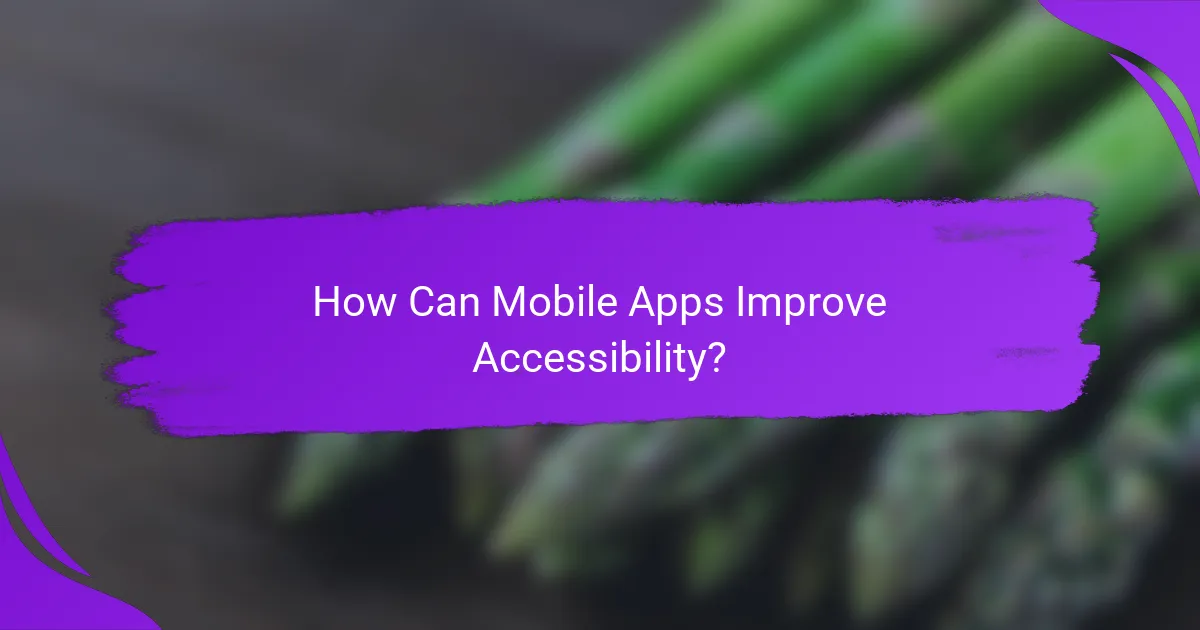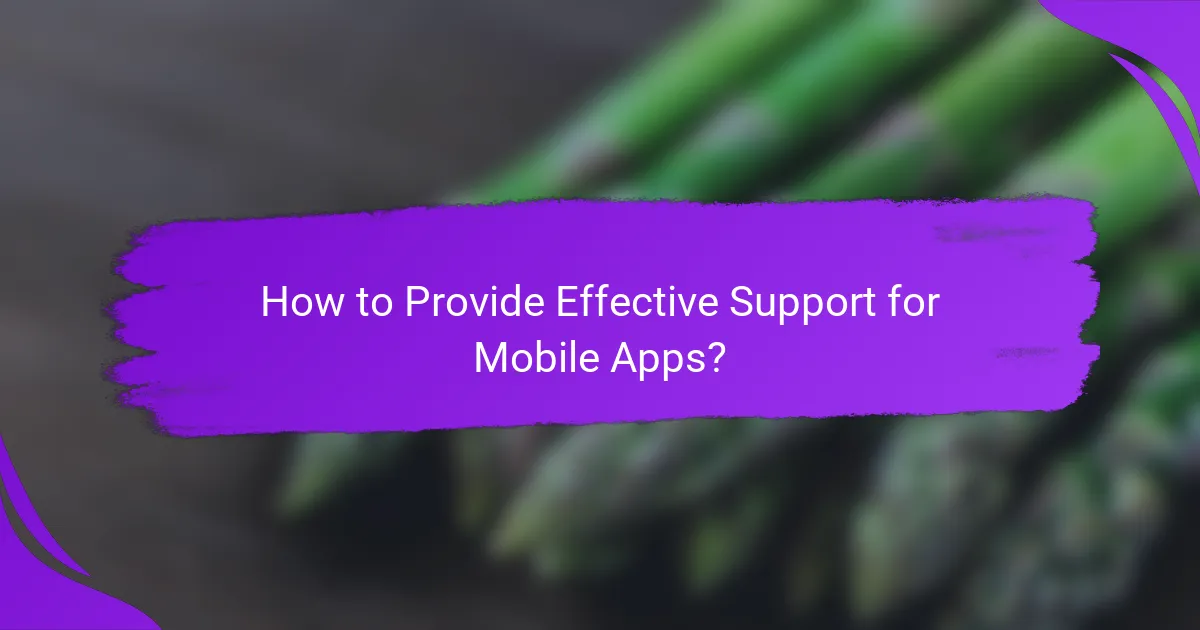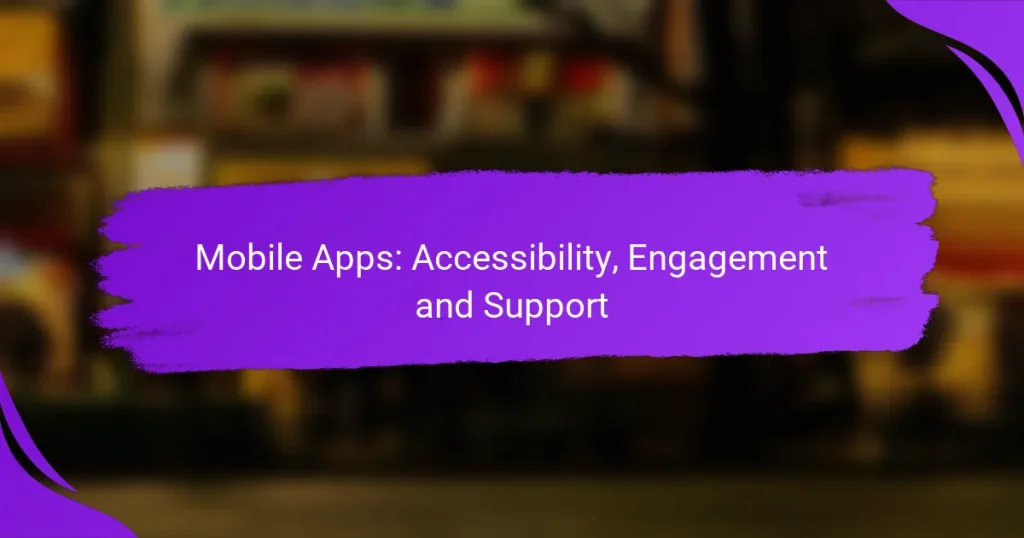Mobile apps play a crucial role in enhancing accessibility, ensuring that users with diverse needs can interact with technology effectively. By implementing engagement strategies that foster user interaction and retention, these apps create personalized experiences that keep users invested. Additionally, providing robust support options is essential for resolving issues swiftly, ultimately boosting user satisfaction and loyalty.

How Can Mobile Apps Improve Accessibility?
Mobile apps can significantly enhance accessibility by incorporating features that accommodate users with varying needs. These enhancements ensure that individuals with disabilities can effectively interact with the app, leading to a more inclusive digital experience.
Screen reader compatibility
Screen reader compatibility allows visually impaired users to navigate mobile apps using audio feedback. Developers should ensure that all text elements, buttons, and images have descriptive labels, enabling screen readers to convey the necessary information. Regular testing with screen readers like VoiceOver for iOS or TalkBack for Android is essential to ensure functionality.
Voice command features
Voice command features enable users to control mobile apps through spoken commands, making them accessible for those with mobility impairments. Implementing voice recognition technology can streamline navigation and task completion. It’s important to provide clear instructions and feedback to users to enhance their experience.
Customizable text sizes
Customizable text sizes allow users to adjust font sizes according to their preferences, improving readability for individuals with visual impairments. Apps should support dynamic text resizing, which can be achieved by using scalable units in design. Offering a range of text size options can cater to diverse user needs.
Color contrast settings
Color contrast settings help users with color blindness or low vision by allowing them to adjust color schemes for better visibility. Apps should provide options to modify background and text colors to meet accessibility standards, such as the Web Content Accessibility Guidelines (WCAG). High contrast themes can significantly enhance usability for affected users.
Accessibility testing tools
Accessibility testing tools are essential for identifying potential barriers within mobile apps. Tools like Axe, WAVE, or Lighthouse can help developers assess compliance with accessibility standards. Regular audits using these tools can uncover issues that may hinder user experience, allowing for timely improvements.

What Engagement Strategies Work for Mobile Apps?
Effective engagement strategies for mobile apps include techniques that enhance user interaction and retention. These strategies leverage timely communication, interactive features, and personalized experiences to keep users invested in the app.
Push notifications
Push notifications are messages sent directly to a user’s device, prompting them to engage with the app. They can be used to inform users about new features, updates, or personalized offers. To be effective, notifications should be timely, relevant, and not overly frequent to avoid user fatigue.
Consider segmenting your audience to tailor notifications based on user behavior and preferences. For example, sending a special offer to users who haven’t engaged in a while can encourage them to return.
In-app messaging
In-app messaging provides users with information or prompts while they are actively using the app. This method allows for real-time communication and can guide users through features or highlight new content. It is essential to ensure that messages are contextually relevant and enhance the user experience rather than disrupt it.
Utilizing in-app messages for onboarding new users can significantly improve their understanding of app functionalities, leading to higher retention rates. Keep messages concise and actionable to maintain user interest.
Gamification elements
Gamification incorporates game-like features into the app to boost user engagement. Elements such as points, badges, leaderboards, and challenges can motivate users to interact more frequently. These features tap into users’ competitive instincts and can create a sense of achievement.
When implementing gamification, ensure that the rewards are meaningful and relevant to your audience. For instance, offering discounts or exclusive content for achieving certain milestones can enhance user loyalty.
User feedback loops
User feedback loops involve collecting and analyzing user input to improve the app continuously. This can be achieved through surveys, ratings, or direct feedback options within the app. Regularly soliciting feedback shows users that their opinions matter and can lead to valuable insights for enhancements.
To create effective feedback loops, consider incentivizing users to provide feedback, such as offering small rewards or recognition. Additionally, communicate any changes made based on user feedback to reinforce their importance in the app’s development.
Personalized content
Personalized content tailors the app experience to individual users based on their preferences, behaviors, and demographics. This strategy can significantly enhance user engagement by making the content more relevant and appealing. Utilizing data analytics can help in understanding user patterns and preferences.
Implementing personalized recommendations, such as suggesting products or articles based on past interactions, can increase user satisfaction and retention. However, it is crucial to balance personalization with privacy concerns, ensuring that users feel comfortable with how their data is used.

How to Provide Effective Support for Mobile Apps?
Effective support for mobile apps involves offering users multiple channels to resolve issues quickly and efficiently. This can enhance user satisfaction and retention, making it essential to implement a variety of support options tailored to user needs.
In-app help centers
In-app help centers provide users with immediate access to support resources without leaving the application. These centers often include articles, guides, and troubleshooting tips that are relevant to the specific app features.
To create an effective help center, ensure that it is easily accessible from the main interface and organized by topics that reflect common user queries. Consider using search functionality to help users find answers quickly.
Live chat support
Live chat support allows users to communicate directly with support agents in real-time, offering personalized assistance. This method is particularly effective for resolving complex issues that require immediate attention.
When implementing live chat, ensure that agents are well-trained and available during peak usage times. Consider using chatbots for initial queries to streamline the process before connecting users to human agents.
FAQ sections
FAQ sections compile common questions and their answers, providing users with quick solutions to typical problems. This resource can significantly reduce the volume of support requests by addressing frequent concerns proactively.
To maximize effectiveness, regularly update the FAQ section based on user feedback and emerging trends. Organizing questions by category can also enhance usability.
Community forums
Community forums enable users to share experiences and solutions, fostering a sense of belonging and collaboration. These platforms can be invaluable for users seeking advice from peers or sharing tips.
Moderation is key to maintaining a positive environment. Encourage knowledgeable users to participate and consider rewarding them for their contributions to enhance engagement.
Video tutorials
Video tutorials offer visual guidance on using app features, making complex tasks easier to understand. These resources can cater to different learning styles and provide step-by-step instructions.
When creating video content, focus on clarity and conciseness. Short, focused videos that address specific tasks or features tend to be more effective than longer, general overviews. Consider hosting these tutorials on popular platforms to increase accessibility.

What Are the Key Metrics for Measuring Engagement?
Key metrics for measuring engagement in mobile apps include daily active users, session length, and retention rates. These metrics provide insights into how users interact with the app and help identify areas for improvement.
Daily active users
Daily active users (DAU) is a critical metric that indicates the number of unique users who engage with the app on a daily basis. This figure helps assess the app’s popularity and user retention, providing a snapshot of user engagement trends.
To calculate DAU, track the number of distinct users who log in or perform a specific action within the app each day. A healthy DAU typically ranges from a few hundred to several thousand, depending on the app’s target audience and market segment.
To improve DAU, focus on user experience and provide regular updates or new features that encourage daily interaction. Avoid common pitfalls like overwhelming users with notifications, which can lead to disengagement.


